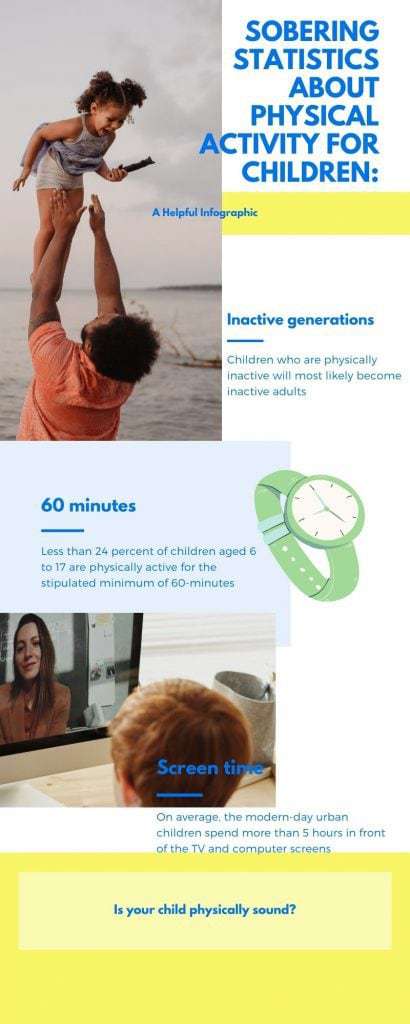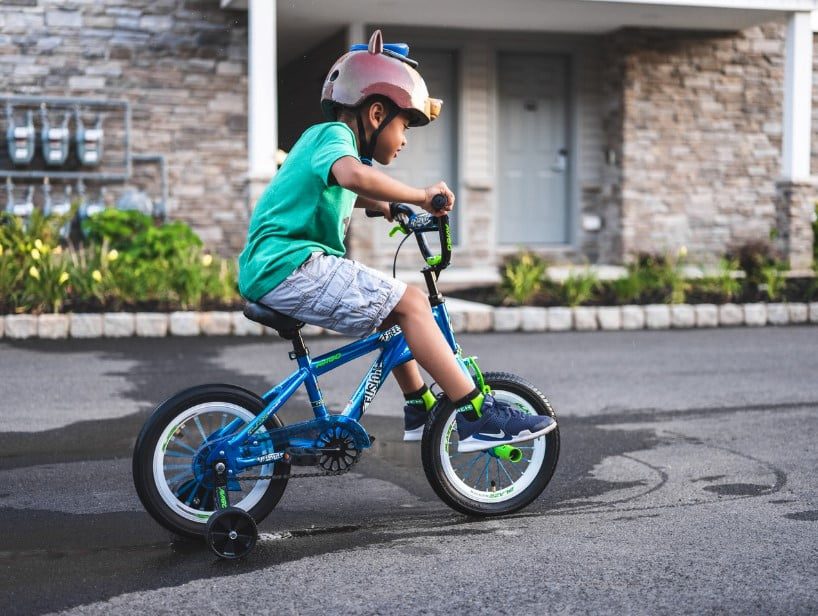The benefits of physical activity for children remain the same today just as they have been for centuries. Consistent physical exertion keeps the body healthy, while fending off infectious and non-communicable illnesses. These include stroke, heart failure, cancer, diabetes, and respiratory diseases.
Physical wellness is receiving renewed interest in the 21st century because of the invasive challenges caused by technology, urbanization, and a whole range of lifestyle changes.
Poor use of digital devices has groomed a sedentary generation, while insufficient living spaces have translated to less room for children to play outdoors.
Physical activity & related statistics:

Exactly what is physical activity?
According to the World Health Organization (WHO), physical activity is
any bodily movement produced by skeletal muscles that requires energy expenditure … Physical activity includes exercise as well as other activities which involve bodily movement and are done as part of playing, working, active transportation, house chores and recreational activities.
Physical wellness is divided loosely in three categories – active play, organized sport, and active transportation:
Active play is the unstructured mode of play where children crawl, walk, run, jump, climb trees, dance, or even swim. This can happen indoors and outdoors.
Organized sport is a structured model of play with set rules which involve more than just one child or youth. Organized sports include football, netball, baseball, and other related forms of sporting activities outdoors and at school.
Active transportation involves body-powered forms of movement such as walking, jogging, running, cycling, canoeing, swimming, and skating. These activities are preferably done outdoors.
As per WHO Global recommendations on physical activity, children should accumulate at least 60 minutes of moderate- to vigorous-intensity physical activity daily.’(MVPA)
While 60 minutes looks achievable, not as many children get to do it, especially those that dwell in urban settings.
The situation is not getting any better, given that urbanization is projected to accelerate in the years to come. According to the United Nations, 68% of the global population will live in urban dwellings by 2050. This is in contrast to only 53% today.
Here are just a few of the benefits of physical activity for children
Aerobics and other forms of physical exertions can enhance cognitive, social, and creative skills in children. This even as they juggle their way inside the expanding digital ecosystem and crammed neighborhoods.
Well, if you are a parent and have your children caught up in the cycle of inactivity, below are reasons to get them running again.
1. Mental benefits of physical activity
Health experts everywhere agree that physical activity is important for brain development, overall health, and mental excellence. And for good reasons:
Medium-to-vigorous physical activity (MVPA) is known to increase blood flow to the brain, to facilitate the supply of much-needed oxygen and nutrients. These are invaluable in boosting the growth of the brain while improving memory and mental wellness.
From birth to 5 years, the brain develops in response to the environment, sleep, physical activity, nutrition, human interactions, and everything else – positive and negative.
Sustained MVPA, or lack of it, will prepare young children to excel or fail in life and academics, with consequences lasting up to adulthood. Physical wellness from early on is also known to keep dementia (Alzheimer’s disease) out of the way.
Finally, a good amount of physical wellness throughout life helps to slow down the aging of the brain! In fact, regular physical activity can reduce aging by up to 10 years!
2. Nutritional benefits of physical activity
Yes, young children can mean to be quite picky with food and impossible on the dinner table. Apart from trying out a few sneaky tricks to get your child to eat again, you can use physical activity, as a catalyzer.
What happens is that the level of Ghrelin (the hunger hormone) in the stomach will increase as glucose is used up. This will alert the brain to trigger a hunger spike, forcing the child to develop the urge to eat. This should just about get your child back to the dining table.
On a healthy note, the burning of glucose is good news since it helps reduce sugar levels in the body.
You can also use this opportunity to smuggle in nutritious serving your child dislikes. After a physical marathon and hunger, your child will readily eat whatever is served on the dinner table.
While children need 60 minutes of physical exertion every other day, more of it is actually better.
3. Physical exercise for body growth
Consistent physical exercise strengthens bones, muscles, and heart, to facilitate a lean and healthy body.
Consistent physical wellness energizes the bones and muscles to boost physical endurance.
During the first years of life, body growth is manifested in what is known as growth spurts. During this time, the child actually grows in height and weight. For this growth to happen as per the recommended development milestones, the child should also get sufficient sleep.
You should be concerned, however, when your child gains weight even after sustained physical activities. This could be a sign of diabetes, bad eating habits, or even a genetic anomaly. In many cases, it may require prompt medical attention.
4. Emotional benefits of physical exercise
Emotional stress and depression are synonymous with all children. Stress can bring down even the very strong among us. Preparing children to deal with mental challenges is, therefore, very important.
Children are more vulnerable to emotional challenges simply because they lack the necessary experience that adults accumulated over the years.
Physical activity is only one of the ways children prepare for emotional and other stressful challenges in life. Because they are busy running up and down, they spend less time worrying about negative emotions.
According to American Psychological Association,
We now understand much more about effective strategies for reducing stress responses. Such beneficial strategies include: …Engaging in regular physical exercise.
In addition, physical exercise is instrumental in fighting boredom, improving confidence and self-esteem, factors that are crucial in emotional development.
5. Health benefits of physical activity
The overall health of a child is a reflection of mental, physical, emotional, and social wellness, and starts very early in life. It also helps reduce the onset of illnesses, and in many cases, eradicates others completely.
Sustained physical activities will neutralize the following conditions and illnesses:
- heart disease
- stroke
- type-2 diabetes
- blood pressure
- tech-neck
- body posture
- sleep disorder
- regulates the sedentary lifestyle
- hunger disorders
In those with lung-related illnesses such as asthma, physical exercise is fundamental in boosting lung capacity which in turn cuts down on inflammation.
Besides keeping diseases at bay, here are the other benefits of physical activity for children:
- keeps children away from the TV, computer and game consoles – at least for a few hours!
- is a good enabler for socialization
- creates opportunities for physical skills in sports and games
6. Social benefits of physical activity
Children get the opportunity to enjoy the fun part of life and interact with peers in the course of physical exercises.
By running together, playing soccer, and having a conversation, they discover a lot about life and their existence.
By interacting with fellow children, they can
- make friends
- become more creative
- improve self-image through networking
- cooperate better with peers
- fight stress and depression better
- cut down on anti-social behavior such as bullying
Overall, children will develop leadership skills, pimp up their self-esteem, become accepted, and have a better sense of empathy, all because of physical involvement derived from physical activities.





Leave a Reply